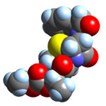Penicillin Kills Bacteria Via Death Peptide

By Tom Hollon
Programmed cell death, or apoptosis, the process in which cells self-destruct by fragmentation, is connected to the way penicillin and some other antibiotics kill bacteria. Research by Rodger Novak of New York Medical Center and Elaine Tuomanen and her colleagues at St. Jude Children's Research Hospital (Memphis, TN) demonstrates penicillin uses a death signal peptide to unleash bacterial cell death programs.
The discovery, reported in the January issue of Molecular Cell, marks a step forward in understanding how penicillin works. It has long been known that penicillin stops bacterial growth when it binds proteins called peptidoglycans in the bacterial cell wall. But binding the cell wall does not directly cause death, and explaining how penicillin kills bacteria remains an unfinished task.
The earliest explanation, that disruption of the cell wall led to cell rupture by osmotic pressure, was abandoned when it was found that penicillin binding of peptidoglycans somehow activated suicidal bacterial enzymes called autolysins. Autolysins are normally tightly controlled and used to cleave the cell wall to allow cell growth and cell separation.
Out of control, they cause rapid death by cell lysis.
The researchers explored how penicillin kills bacteria by isolating mutants of Streptococcus pneumoniae that had active autolysin systems but that were not killed by penicillin. They found one mutant that resisted both penicillin and vancomycin, and examined the genes whose mutations enabled survival against two antibiotics.
Their studies revealed a four-component system that controls penicillin and vancomycin activation of autolysins—a 27 amino acid peptide and a transporter protein for sending it outside the cell and a two-protein signaling system that detects the peptide.
They found the peptide to be a death signal, stopping growth and inducing autolysis when added to cells. The peptide was essential to cell suicide: S. pneumoniae in which the peptide gene was inactivated did not die in the presence of penicillin or vancomycin. In similar experiments, they found the proteins detecting the death signal peptide were also essential.
The death signal peptide seems to work only against its own species; it failed to kill other streptococcal species or Staphylococcus aureus. Novak believes it is highly likely other bacteria will have similar death peptide systems.
The death signal peptide killed even when the principle autolysin, LytA, was inactive, indicating penicillin activates more than one bacterial death pathway. Here there are clinical implications: Sometimes bacteria in the body become tolerant to antibiotics because their autolytic pathways become inactive. Closer study of these pathways may yield better understanding of how antibiotics induce cell death and new targets for antibiotic development, especially ones that can kill bacteria with inactive autolysins.
Reference
R. Novak et al., Signaling Transduction by a Death Signal Peptide:
Uncovering the Mechanism of Bacterial Killing by Penicillin. Molecular
Cell 5, 49-57, 2000.
About the Author
Tom Hollon is a science writer and editor based in Rockville, MD. He was the founding editor of the journal Modern Drug Discovery. Prior to that, Tom conducted research at the National Institutes of Health, the Pasteur Institute, and the University of Washington. He can be reached at thollon@starpower.net.
